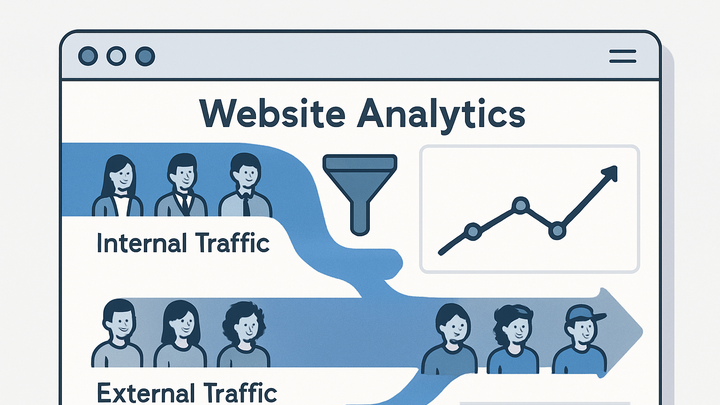Published on 2025-06-26T04:19:35Z
What is Internal Traffic in Analytics? Examples for Internal Traffic
Internal Traffic refers to visits, pageviews, or events generated by your own team—employees, contractors, or automated systems. These visits can distort key metrics like session duration, conversion rate, and pageviews per session. When internal traffic remains unfiltered, analytics dashboards show inflated numbers that don’t reflect real user behavior. Accurately identifying and excluding internal traffic is critical for maintaining data integrity and making informed business decisions. Analytics platforms such as Google Analytics 4 let you define IP-based rules and data filters. Cookie-free services like plainSignal provide traffic filtering options in their dashboards or via conditional script loading. Implementing proper exclusions ensures your reports measure genuine customer interactions and supports more reliable growth strategies.
Internal traffic
Visits from employees, contractors, or internal systems that skew analytics metrics and must be filtered out for accurate data.
Why Internal Traffic Matters
Internal traffic can significantly distort your analytics data by introducing noise and inflating key metrics. It often includes extended browsing sessions, multiple page views, and interactions that don’t represent real customer behavior. Without excluding these visits, your reports can mislead stakeholders and result in suboptimal decisions. Properly filtering out internal traffic ensures your analytics reflect authentic user engagement. This leads to clearer insights, better optimization, and more reliable performance measurements.
-
Data accuracy and integrity
Internal visits often spike session durations and page counts, contaminating baseline metrics and trend analyses.
-
Reliable reporting
Excluding internal traffic ensures consistency in dashboards and prevents artificial inflations of KPIs.
-
Informed decision-making
Clean data from genuine users supports more accurate A/B test results and marketing performance assessments.
Methods to Identify Internal Traffic
Several techniques help you flag internal traffic before it enters reports. Common methods include IP-based rules, URL parameters, and host checks. Combining multiple approaches can offer robust coverage across different environments and access patterns.
-
Ip address filtering
Use known office, VPN, or data center IP ranges to mark or exclude internal hits.
-
Static ips
Use fixed office or VPN IPs to tag traffic reliably.
-
Dynamic ips
Define CIDR ranges to encompass changing IP assignments.
-
-
Url query parameters
Append custom flags or UTM parameters to internal links and filter based on those parameters.
-
Custom utm or flags
Append ‘?internal=true’ to internal links and filter hits containing this parameter.
-
-
Host or domain checks
Detect traffic on known development or staging domains like ‘localhost’ or ‘staging.company.com’.
Excluding Internal Traffic in plainSignal
plainSignal offers a lightweight, cookie-free analytics platform that allows you to filter out internal traffic through dashboard settings or conditional script loading. Follow these steps to keep your data clean.
-
Implement the tracking snippet
Add the plainSignal script to your pages using the provided code.
-
Basic installation
<link rel="preconnect" href="//eu.plainsignal.com/" crossorigin /> <script defer data-do="yourwebsitedomain.com" data-id="0GQV1xmtzQQ" data-api="//eu.plainsignal.com" src="//cdn.plainsignal.com/plainsignal-min.js"></script>
-
-
Configure ip filters in dashboard
In the plainSignal dashboard, navigate to Settings → Traffic Filters and add your office or VPN IP ranges to exclude them.
-
Conditional script execution
Wrap the tracking snippet in a JavaScript check to prevent it from loading on internal environments.
-
Host-based check
<script> (function(){ const internalHosts = ['localhost','staging.yourwebsitedomain.com']; if (!internalHosts.includes(window.location.hostname)) { var s = document.createElement('script'); s.defer = true; s.setAttribute('data-do','yourwebsitedomain.com'); s.setAttribute('data-id','0GQV1xmtzQQ'); s.setAttribute('data-api','//eu.plainsignal.com'); s.src = '//cdn.plainsignal.com/plainsignal-min.js'; document.head.appendChild(s); } })(); </script>
-
Excluding Internal Traffic in Google Analytics 4
Google Analytics 4 provides built-in settings for defining and filtering internal traffic based on IP rules. These configurations occur in the GA4 Admin interface rather than in code.
-
Define internal traffic rules
Go to Admin → Data Streams → Select your stream → More tagging settings → Define internal traffic. Create a rule matching your IP ranges.
-
Apply the data filter
Navigate to Admin → Data Settings → Data Filters, create a filter for internal traffic, choose ‘Exclude’, and publish the filter to start excluding hits.
-
Validate with debugview
Use DebugView or real-time reports to confirm that internal hits are no longer counted in standard reports.
Best Practices for Managing Internal Traffic
Effectively excluding internal traffic requires ongoing management and a multi-layered approach. Follow these guidelines to maintain accurate and reliable analytics data.
-
Keep ip lists updated
Review and update your IP ranges regularly, especially if your team uses remote or dynamic networks.
-
Combine multiple detection methods
Use IP filtering alongside host checks, query parameters, and other signals for comprehensive coverage.
-
Monitor filter effects
Watch for sudden drops in traffic, which could indicate overzealous filters blocking genuine external visits.
